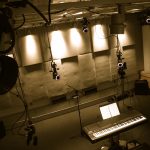Authors:
Catherine Massie-Laberge, Isabelle Cossette, Marcelo M. WanderleyPublication or Conference Title:
Frontiers in PsychologyAbstract:
Established pedagogical theories for classical piano usually do not consider the essential relationship between the musical structure, whole body movements, and expression. Research focusing on musicians’ expression has shown that body movements reflect the performer’s understanding of the musical structure. However, most studies to date focus on the performance of a single piece at a time, leaving unanswered the question on how structural parameters of pieces with varied technical difficulties influence pianists’ movements. In this study, 10 pianists performed three contrasting Romantic excerpts in terms of technical level and character, while motion data was collected with a passive infrared motion capture system. We observed how pianists modulate their performances for each of the three pieces and measured the absolute difference in percentage of duration and quantity of motion (QoM) between four expressive conditions (normal, deadpan, exaggerated, immobile). We analyzed common patterns within the time-series of position data to investigate whether pianists embody musical structure in similar ways. A survey was filled in by pianists to understand how they conceive the
relationship between body movements and musical structure. Results show that the variation in duration between the exaggerated and deadpan conditions was significant in one measure for one of the excerpts, and that tempo was less affected by the QoM used than by the level of expression. By applying PCA on the pianists’ position data, we found that the head QoM is an important parameter for communicating different expressions and structural features. Significant variations in head QoM were found in the immobile and deadpan conditions if compared to the normal condition, only in specific regions of the score. Recurrent head movements occurred along with certain structural parameters for two of the excerpts only. Altogether, these results indicate that the analysis of pianists’ body movements and expressive intentions should be carried out in relation to the specific musical context, being dependent on the technical level of the pieces and the repertoire. These results, combined with piano teaching methods, may lead to the development of new approaches in instrumental lessons to help students make independent choices regarding body movements and expression.
Publication Details:
Type: |
Journal Paper |
Date: |
01/10/2019 |
Volume: |
9 |
DOI: |
https://doi.org/10.3389/fpsyg.2018.02725 |

